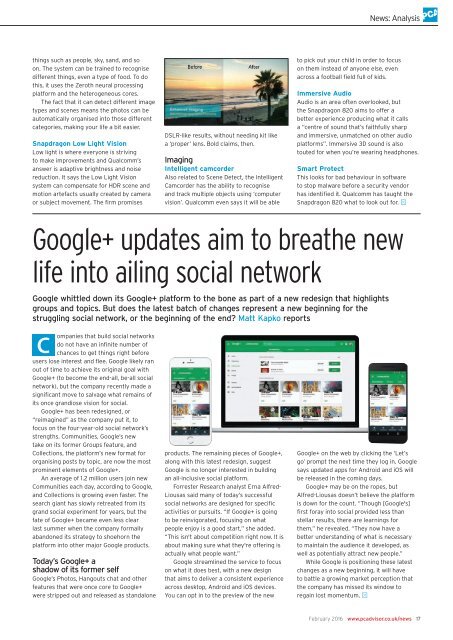Create successful ePaper yourself
Turn your PDF publications into a flip-book with our unique Google optimized e-Paper software.
News: Analysis<br />
things such as people, sky, sand, and so<br />
on. The system can be trained to recognise<br />
different things, even a type of food. To do<br />
this, it uses the Zeroth neural processing<br />
platform and the heterogeneous cores.<br />
The fact that it can detect different image<br />
types and scenes means the photos can be<br />
automatically organised into those different<br />
categories, making your life a bit easier.<br />
Snapdragon Low Light Vision<br />
Low light is where everyone is striving<br />
to make improvements and Qualcomm’s<br />
answer is adaptive brightness and noise<br />
reduction. It says the Low Light Vision<br />
system can compensate for HDR scene and<br />
motion artefacts usually created by camera<br />
or subject movement. The firm promises<br />
DSLR‐like results, without needing kit like<br />
a ‘proper’ lens. Bold claims, then.<br />
Imaging<br />
Intelligent camcorder<br />
Also related to Scene Detect, the Intelligent<br />
Camcorder has the ability to recognise<br />
and track multiple objects using ‘computer<br />
vision’. Qualcomm even says it will be able<br />
to pick out your child in order to focus<br />
on them instead of anyone else, even<br />
across a football field full of kids.<br />
Immersive Audio<br />
Audio is an area often overlooked, but<br />
the Snapdragon 820 aims to offer a<br />
better experience producing what it calls<br />
a “centre of sound that’s faithfully sharp<br />
and immersive, unmatched on other audio<br />
platforms”. Immersive 3D sound is also<br />
touted for when you’re wearing headphones.<br />
Smart Protect<br />
This looks for bad behaviour in software<br />
to stop malware before a security vendor<br />
has identified it. Qualcomm has taught the<br />
Snapdragon 820 what to look out for. J<br />
Google+ updates aim to breathe new<br />
life into ailing social network<br />
Google whittled down its Google+ platform to the bone as part of a new redesign that highlights<br />
groups and topics. But does the latest batch of changes represent a new beginning for the<br />
struggling social network, or the beginning of the end? Matt Kapko reports<br />
C<br />
ompanies that build social networks<br />
do not have an infinite number of<br />
chances to get things right before<br />
users lose interest and flee. Google likely ran<br />
out of time to achieve its original goal with<br />
Google+ (to become the end‐all, be‐all social<br />
network), but the company recently made a<br />
significant move to salvage what remains of<br />
its once grandiose vision for social.<br />
Google+ has been redesigned, or<br />
“reimagined” as the company put it, to<br />
focus on the four‐year‐old social network’s<br />
strengths. Communities, Google’s new<br />
take on its former Groups feature, and<br />
Collections, the platform’s new format for<br />
organising posts by topic, are now the most<br />
prominent elements of Google+.<br />
An average of 1.2 million users join new<br />
Communities each day, according to Google,<br />
and Collections is growing even faster. The<br />
search giant has slowly retreated from its<br />
grand social experiment for years, but the<br />
fate of Google+ became even less clear<br />
last summer when the company formally<br />
abandoned its strategy to shoehorn the<br />
platform into other major Google products.<br />
Today’s Google+ a<br />
shadow of its former self<br />
Google’s Photos, Hangouts chat and other<br />
features that were once core to Google+<br />
were stripped out and released as standalone<br />
products. The remaining pieces of Google+,<br />
along with this latest redesign, suggest<br />
Google is no longer interested in building<br />
an all‐inclusive social platform.<br />
Forrester Research analyst Erna Alfred‐<br />
Liousas said many of today’s successful<br />
social networks are designed for specific<br />
activities or pursuits. “If Google+ is going<br />
to be reinvigorated, focusing on what<br />
people enjoy is a good start,” she added.<br />
“This isn't about competition right now. It is<br />
about making sure what they're offering is<br />
actually what people want.”<br />
Google streamlined the service to focus<br />
on what it does best, with a new design<br />
that aims to deliver a consistent experience<br />
across desktop, Android and iOS devices.<br />
You can opt in to the preview of the new<br />
Google+ on the web by clicking the ‘Let’s<br />
go’ prompt the next time they log in. Google<br />
says updated apps for Android and iOS will<br />
be released in the coming days.<br />
Google+ may be on the ropes, but<br />
Alfred‐Liousas doesn’t believe the platform<br />
is down for the count. “Though [Google's]<br />
first foray into social provided less than<br />
stellar results, there are learnings for<br />
them,” he revealed. “They now have a<br />
better understanding of what is necessary<br />
to maintain the audience it developed, as<br />
well as potentially attract new people.”<br />
While Google is positioning these latest<br />
changes as a new beginning, it will have<br />
to battle a growing market perception that<br />
the company has missed its window to<br />
regain lost momentum. J<br />
February 2016 www.pcadvisor.co.uk/news 17






